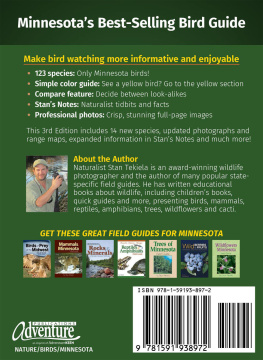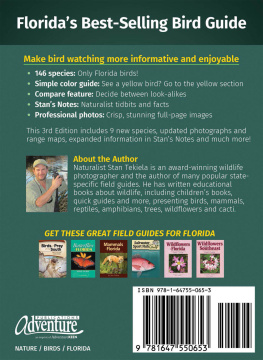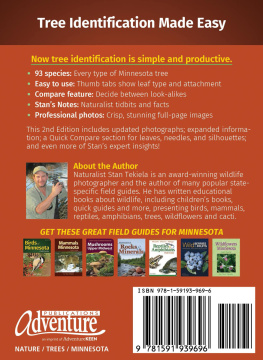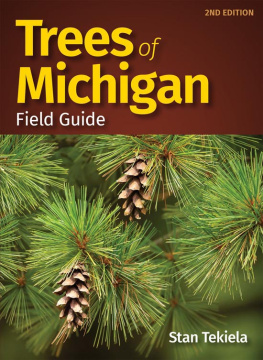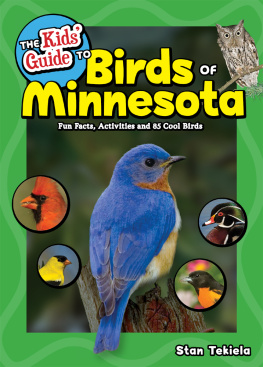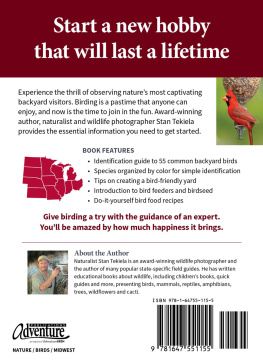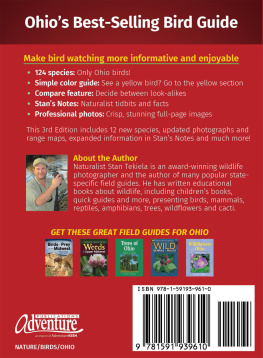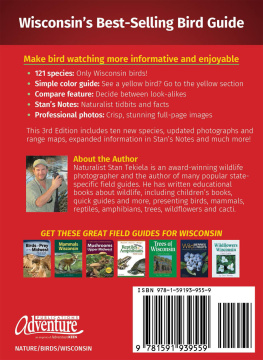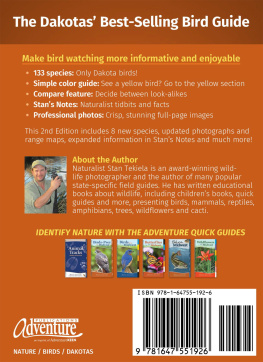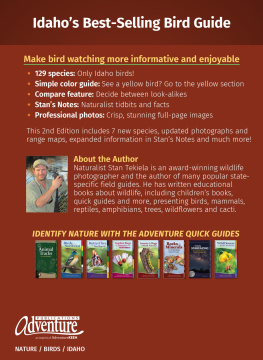

Edited by Sandy Livoti
Cover, book design and illustrations by Jonathan Norberg
Range maps produced by Anthony Hertzel
Cover photo: Black-capped Chickadee by Stan Tekiela
All photos by Stan Tekiela except () by Jim Zipp
To the best of the publishers knowledge, all photos were of live birds. Some were photographed in a controlled condition.
10 9 8 7 6 5 4 3 2 1
Birds of Minnesota Field Guide
First Edition 1998
Second Edition 2004
Third Edition 2019
Copyright 1998, 2004 and 2019 by Stan Tekiela
Published by Adventure Publications
An imprint of AdventureKEEN
330 Garfield Street South
Cambridge, Minnesota 55008
(800) 678-7006
www.adventurepublications.net
All rights reserved
Printed in China
ISBN 978-1-59193-897-2 (pbk.); ISBN 978-1-59193-898-9 (ebook)
Dedication
To my wife, Katherine, and daughter, Abigail, with all my love.
Acknowledgments
Many thanks to the National Wildlife Refuge System along with state and local agencies, both public and private, for stewarding the lands that are critical to the many bird species we so love.
TABLE OF CONTENTS
WHATS NEW?
It is hard to believe that its been more than 20 years since the debut of Birds of Minnesota Field Guide . This critically acclaimed field guide has helped countless people identify and enjoy the birds that we love. Now, in this expanded third edition, Birds of Minnesota Field Guide has many new and exciting changes and a fresh look, while retaining the same easy-to-use, familiar format.
To help you identify even more birds in Minnesota, I have added 14 new species and am featuring 143 new color photographs. All of the range maps have been meticulously reviewed, and many updates have been made to reflect the ever-changing movements of the birds.
Everyones favorite section, Stans Notes, has been expanded to include even more natural history information. Compare sections have been updated to help ensure that you correctly identify your bird, and additional feeder information has been added to help with bird feeding. I hope you will enjoy this great new edition as you continue to learn about and appreciate our Minnesota birds!

WHY WATCH BIRDS IN MINNESOTA?
Millions of people in Minnesota have discovered bird feeding. Setting out feeders is a simple and enjoyable way to bring birds and their beauty closer to you. Watching birds at your feeders and listening to them often leads to a lifetime pursuit of bird identification. Birds of Minnesota Field Guide is for those who want to identify the common birds of Minnesota.
More than 1,100 species of birds are found in North America. In Minnesota, upwards of 425 species of birds were documented throughout the years. These bird sightings were diligently recorded by hundreds of bird watchers and became part of the official state records. From these, I have chosen 123 of the most common birds of Minnesota to include in this field guide.
Bird watching, also called birding, is one of the most popular activities in America. Its outstanding appeal in Minnesota is due to unusually rich and abundant birdlife all around the state.
At nearly 87,000 square miles (225,300 sq. km), Minnesota is the twelfth-largest state in the country. Despite its large size, it has a population of only about 5.5 million. This is only about half the population in the Chicagoland area of Illinois! Since many Minnesotans live in or near major cities, there is plenty of room around the state for a wide variety of birds to roam.
Several distinct habitats in Minnesota support different groups of birds. Vast evergreen (coniferous) forests with thousands of lakes, streams, rivers and bogs grace the northeastern third of the state. These woods are havens for Evening Grosbeaks, Common Ravens and many warbler species. Common Loons and Hooded Mergansers dive for fish in the clean, clear lakes, and Ring-billed Gulls flock to the cold waters and rocky shores of the greatest of all lakes, Lake Superior.
A band of deciduous forest stretches from the northwest part of the state to the hills of southeastern Minnesota. Here, Scarlet Tanagers, Eastern Phoebes, Downy Woodpeckers and other woodland birds make their homes. In these forests, Barred and Great Horned Owls hunt for food and raise families.
Open prairie habitat in southwestern Minnesota attracts many other species of birds. As Eastern Meadowlarks sing melodies and Tree Swallows perch on fences, Eastern Kingbirds hunt for insects. High above, Red-tailed Hawks soar in the sunlit sky.
The mighty Mississippi River and several other major rivers run through Minnesota. Our river valleys, lined with tall shade trees and flowing with cool water, are outstanding places for other birds. Black-crowned Night-Herons and Great Egrets are among the many waterbirds that nest here.
Complementing our wide-ranging seasonal weather, we have a wide range of birds to enjoy in each season. From the hawks migrating in the fall to the hummingbirds returning in spring, there is variety and excitement in birding at any time of year!
OBSERVATION STRATEGIES: TIPS TO IDENTIFY BIRDS
Identifying birds isnt as difficult as you might think. By simply following a few basic strategies, you can increase your chances of successfully identifying most birds that you see! One of the first and easiest things to do when you see a new bird is to note its color. This field guide is organized by color, so simply turn to the right color section to find it.
Next, note the size of the bird. A strategy to quickly estimate size is to compare different birds. Pick a small, a medium and a large bird. Select an American Robin as the medium bird. Measured from bill tip to tail tip, a robin is 10 inches (25 cm).
Now select two other birds, one smaller and one larger. Good choices are a House Sparrow, at about 6 inches (15 cm), and an American Crow, around 18 inches (45 cm). When you see a species you dont know, you can now quickly ask yourself, Is it larger than a sparrow but smaller than a robin? When you look in your field guide to identify your bird, you would check the species that are roughly 610 inches (1525 cm). This will help to narrow your choices.
Next, note the size, shape and color of the bill. Is it long, short, thick, thin, pointed, blunt, curved or straight? Seed-eating birds, such as Northern Cardinals, have bills that are thick and strong enough to crack even the toughest seeds. Birds that sip nectar, such as Ruby-throated Hummingbirds, need long, thin bills to reach deep into flowers. Hawks and owls tear their prey with very sharp, curving bills. Sometimes, just noting the bill shape can help you decide whether the bird is a woodpecker, sparrow, grosbeak, blackbird or bird of prey.
Next, take a look around and note the habitat in which you see the bird. Is it wading in a marsh? Walking along a riverbank? Soaring in the sky? Is it perched high in the trees or hopping along the forest floor? Because of diet and habitat preferences, youll often see robins hopping on the ground but not usually eating seeds at a feeder. Or youll see a Blue Jay sitting on a tree branch but not climbing headfirst down a tree trunk, like a White-breasted Nuthatch.
Noticing what a bird is eating will give you another clue to help you identify the species. Feeding is a big part of any birds life. Fully one-third of all bird activity revolves around searching for food, catching prey and eating.
Next page
